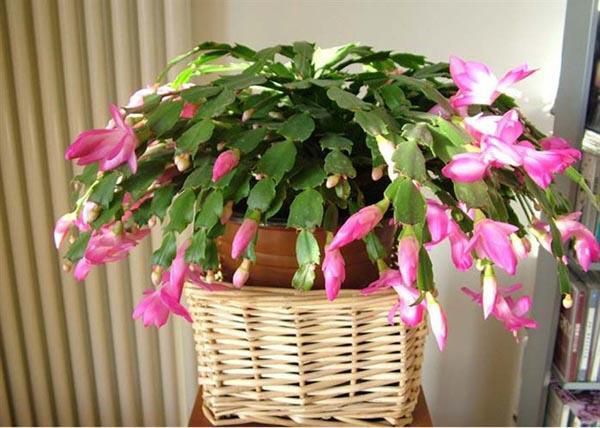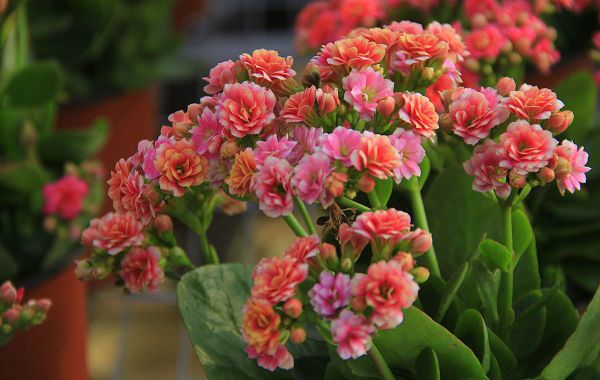How to cultivate the best crab claw orchid
Crab claw orchid is a kind of epiphytic succulent plant in tropical rain forest, its leaves degenerate into flattened abnormal stems shaped like leaves, giving full play to the function of leaves. On both sides of the stem, there are 2-4 coarse serrations, no thorns on the stem, but many branches, showing a drooping shape, stem nodes connected, shaped like crab claws, hence the name. Flowering at the top of the stem, flowers sessile, funnel-shaped, double-petal, each two petals relative to each other, and rolled outward. There are deep purple, rose, pink, yellow, white and so on. Some bloom before New Year's Day, but also during the Spring Festival, the flowering period is as long as 30 to 40 days. A grafted, properly supported three-year-old crab claw orchid, with a crown diameter of up to 70cm and 100cm, with stem nodes hanging upside down outside the basin, with emerald green and red flowers, can bloom 20000cm at the same time, which is very spectacular. In the cold winter season, it is actually a good product to watch, and it is deeply loved by the majority of flower lovers.
Although the crab claw orchid is a cactus plant, it is different from many kinds of cactus climbing plants that people see every day. It likes shade, ventilation and humid environment, afraid of heat and cold, directly shot by the hot sun or rain, will be hurt, such as in the air dry exercise, hot and stuffy conditions, not only poor growth, but also can not blossom, but also attract red spiders. It is better for basin soil to be fertile, loose and slightly acidic soil rich in humus. The key points of management throughout the year are as follows:
The main results are as follows: (1) Spring management: after the flower fade in winter, cut off the 3-4 stem nodes under the residual flowers in time, and remove some old stems and over-dense stem nodes at the same time, in order to achieve the purpose of shaping and ventilation. After flowering in March, there is a short dormant period, so stop fertilizer and control water, wait until new buds emerge from stem nodes, and then carry out normal water and fertilizer management. The watering times should increase with the increase of temperature, so that the basin soil is not dry and watered, and it is better to keep it moist. When the air is too dry, the stems and leaves can be properly sprayed with water, applying dilute nitrogen fertilizer once every 10 to 15 days, from March to April. In order to facilitate water seepage, fill a layer of pebbles of about 3 centimeters at the bottom of the basin, and then cover the soil with base fertilizer, which is better with mature poultry manure containing more phosphorus. Cover the base fertilizer with thin soil to plant seedlings, which should be cultivated with slightly acidic soil instead of alkaline soil.
(2) maintenance and management in summer: crab claw orchid can grow slowly at 15 degrees; when the air is moist at about 25 degrees, it grows faster; when the temperature exceeds 30 degrees, even in a shady environment, the growth rate gradually decreases and enters the semi-dormant state. Crab claw orchid should be put in the cool place under the balcony shade shed at this time, or hang in the indoor ventilation place, in order to prevent the hot sun and shelter from the rain. Spray water frequently to increase the humidity to lower the temperature. If slightly exposed to the sun, or in a sultry place, the plant will be burned, causing stem nodes to wilt, fall off and die. Summer watering can not be too much, can not be fertilized, otherwise it will lead to rotten root death.
(3) maintenance and management in autumn and winter: the temperature in early autumn is still high, leaf spraying and environmental sprinkling should continue. Since September, the climatic conditions are gradually suitable for the growth of crab claw orchid. In mid-and late September, sunshine can be seen sooner or later as the temperature drops. In the middle and last ten days of October, all-day sunshine should be provided to promote flower bud differentiation and multiple pregnant buds. In early and mid-November, the temperature turns cold, crab claw orchid to enter the house for the winter, and pay attention to put in a sunny place. However, in the flowering period, direct sunlight should be avoided to prolong the flowering period. Autumn watering should be appropriate, basin soil should still remain moist, do not dry, do not waterlogging. Too dry, too wet, too large temperature difference between day and night, will cause falling flowers and buds. Because of the low temperature in winter, the evaporation of crab claw orchid is also reduced, the growth is slow, and less water is needed, so we should be more careful not to water too much. Too much watering in winter will lead to the death of rotten roots. In autumn and winter, during the blooming period of crab claw orchid, the topdressing solution containing more phosphorus should be applied every 7 to 10 days, and no fertilizer should be applied during flowering. The weather is changeable in winter, so it is necessary to do a good job of heat preservation and ventilation. When the room temperature drops to 5 degrees, it is necessary to keep the crab claw orchid open at about 15 degrees in winter, otherwise it is difficult to bloom even though there are full pots of flowers.
- Prev

Crab claw orchid longevity orchid cut a knife, add some fertilizer, the flowers bloom and burst the pot.
Crab claw orchid longevity orchid cut a knife, add some fertilizer, the flowers bloom and burst the pot.
- Next

The longevity flower turns black. Do so to bring it back to life.
The longevity flower turns black. Do so to bring it back to life.
Related
- Fuxing push coffee new agricultural production and marketing class: lack of small-scale processing plants
- Jujube rice field leisure farm deep ploughing Yilan for five years to create a space for organic food and play
- Nongyu Farm-A trial of organic papaya for brave women with advanced technology
- Four points for attention in the prevention and control of diseases and insect pests of edible fungi
- How to add nutrient solution to Edible Fungi
- Is there any good way to control edible fungus mites?
- Open Inoculation Technology of Edible Fungi
- Is there any clever way to use fertilizer for edible fungus in winter?
- What agents are used to kill the pathogens of edible fungi in the mushroom shed?
- Rapid drying of Edible Fungi

